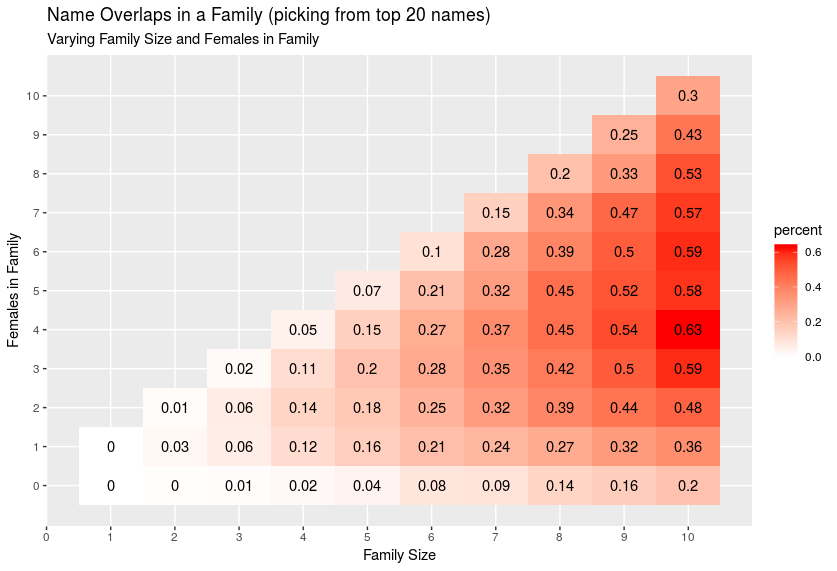Required reading to understand the importance of this post: the poem Too Many Daves by Dr. Seuss. Please read before continuing.
Dr. Seuss here highlights a serious problem: having the same name in the family can lead to serious confusion. If you don’t take care with naming your children, you will have name overlap, and by that point it will be too late.
You may think yourself clever. Perhaps your thinking “Well, I’ll just name my children all different names! Who even names all their kids Dave!?”
Don’t be lulled into this false sense of security. The real danger is not in accidentally naming all 23 of your children Dave. It’s the pesky people that marry into your family that pose the threat of name overlap. There is nothing stopping them from marrying someone with a name that your family already has.
Now, you may be thinking that the probability of a person in your family marrying someone with a name your family already has is low. There may have been a time that I thought that as well. But the cold, harsh truth has reared its ugly face in my own life. That’s right, within my immediate family, we have not one, not two, but three name overlaps.
Two of my sisters married men with the same name. One of my wife’s sisters married a guy named the same name as one of my wife’s brothers. And one of my sister-in-laws has a homonym for one of my sisters names! Now, we live in this hellish family dynamic where we have to jump through all sorts of verbal hoops and perform myriads of linguistic gymnastics to sort this out in everyday conversation.
It is a nightmare.
And I don’t think it’s all that uncommon. Let’s try to find out how common name overlaps are, and how they can be avoided.
Methodology and Data
So this investigation is a simulation, not a survey. I just take the probability distributions from Social Security Administration’s baby names dataset. I simulate families with N children and their spouses. The children are drawn from the top 20 names from the SSA. The spouses are drawn from all the names.
Also, I’m counting name overlaps among children and their spouses. I’m not involving parents, grandparents, uncles, roommates, pets, etc.
Results
Name Diversity Over Time
One quick note about names. Our names have become much more diverse in recent years, as evidenced by the graph below. Back in 1880, the top 20 names for the year accounted for nearly 57.2% of all male names and almost 36.4% for all female names! Compare that to 2017, where the top 20 male names account for below 14.33% and female is 13.3%

Presumably, the name overlap problem would have been much worse in 1880. How did they even work! Every day of their lives was probably a “Too Many Daves” situation!
Only 90's Kids Will Remember...
To keep things simple, let’s just look at names from one year, 1990.
I ran 55 family configurations: from 1 to 10 children, and varying the number of females in the family (0% to 100%). For each configuration, I did 1000 random samples.
As an aside, I’m making two important assumptions. First, I’m assuming all the children are born in 1990. Yes, the simulations with 10 children decuplets! Also, I’m assuming that the children each marry someone also born in 1990 . No marrying someone older/younger than yourself!
Consider the chart below.

Note a couple of things.
First, The higher number of children you have, the higher likelihood of a name overlap. With 5 children, you’re already starting to reach the 20% mark of having a name overlap.
Second, notice how having more equal numbers of male and female children raises the probability. There are still overlaps with all male or all female families, but not as many.
These are pretty high probabilities! But perhaps you’re thinking that this is all contrived, because we’re picking the top 20 names, but if you picked slightly less common names, the probabilities wouldn’t be nearly as high.
Not so. Check out this chart below, which is picking from the top 100 names.

You’re still in the 12-16% range for a family of 5! I feel like that’s high! However, the probabilities do go down across the board. I’m sure that if you picked from the top 1,000 or 10,000 names, you could mitigate the likelihood more.
Conclusion
We identified a few ways to avoid the nightmare of having name overlaps in your immediate family
-
Have fewer children
-
Have all boys or all girls. Equal numbers of each gender is bad news!
-
Name your children with less common names
-
Try your best to not have children in the 1880s.
Unfortunately, my analysis only includes name overlap among children and their spouses. Even in this limited scope, things look grim. And this is for you children you get to name!
I have not taken into account name overlap across in law families, among uncles, grandparents, nieces, or nephews. The problem only gets worse!
So, I guess my parting word is, good luck.